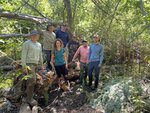
LEAVENWORTH—Along Chumstick Highway, 300 linear feet of Chumstick Creek, which was about an inch deep two weeks prior, is now about a foot deep in some sections after receiving low-tech process-based restoration.
While seemingly insignificant, this small change is slowing the flow of the creek, which creates safe pools for juvenile fish during high water, increases leaf litter storage for macroinvertebrates to eat, and improves habitat for waterfowl and songbirds. Additionally, it rebuilds sediment on an eroded streambed and recharges groundwater, which enhances water quality and supply for both humans and wildlife.
This stream segment is one of hundreds that have undergone this type of restoration through the collaborative effort of Trout Unlimited, Cascadia Conservation District, and Cascade Fisheries.
Like many other streams in the area, Chumstick Creek has been straightened and emptied of large wood over the last hundred years due to surrounding farming and development. Plus, many areas are unable to reintroduce beavers, whose dams pool water and naturally slow streams, because of concerns about beavers felling trees near homes and roads.
“There's nothing that's stopping the water or slowing it,” said Alex Harwell, Cascadia CD Resource Specialist II.
Through low-tech process-based restoration, the work is manually done by humans, creating beaver dam analogs (BDAs), post-assisted log structures (PALS), and adding large wood to restore the creek to more historically natural flows.
“It’s all to mimic those natural processes that have been missed in the past century or two due to simplifications of streams and to land management practices,” said Phillip Klenke, Cascade Fisheries Salmon Habitat Project Manager and Coordinated Resource Management Facilitator.
Slowing water in streams such as Chumstick Creek is critical during high water flows in the spring. With nothing to slow the water from quickly emptying into the Wenatchee River, juvenile fish get flushed out, streambeds erode into deep and narrow channels, and surrounding land is unable to replenish its groundwater. This leads to drier vegetation, and hot, low flows by late summer, making it less inhabitable for fish and other wildlife.
While the ecological benefits of even 300 linear feet span well beyond fish, completing a project even of such a small scale can be grueling. The organizations must find a willing landowner, then go through the permitting process, which can take up to multiple years before work is able to begin.
“There's a reason for that, but it's also like, no, we need to do more now, because these fish are going extinct now, we're in a drought now. It can be really disheartening,” said Harwell.
Once permitting and funding is complete, the teams manually clear out the streams of noxious weeds, move large logs, and strategically add BDAs. This laborious process requires teams to source fresh tree cuttings, hammer posts into the stream, then weave the branches in to form a manmade beaver dam. Each structure must be maintained year after year, slowing the teams’ ability to create more.
“We’re really inefficient compared to beavers,” said Lisa Foster, Trout Unlimited Restoration Program Director.
For many years, the three organizations operated individually on projects like these, overwhelmed by the amount of work needed to be done. By 2019, they decided to try forming a Coordinated Resource Management group (CRM), in which they could pool their resources and coordinate projects, organizing their efforts to have a broader impact. The idea received support from the U.S. Forest Service, who works closely with each organization, as well as the Bureau of Reclamation, who funds Klenke’s position as CRM Facilitator.
“Last year, our three organizations put in about 300 structures just in one season,” said Foster.
Under the CRM group, Klenke, Foster and Harwell are able to coordinate funding, expand labor, and diversify their projects to minimize gaps or overlap. Regular meetings create a space to share what is working, or not working, and adjust accordingly. Additionally, the group is able to leverage their different advantages, such as agreements or partnerships, funding sources, and knowledge bases.
“Trout Unlimited is a national organization. They can pull from other people in their national group. Cascadia is a conservation district, and can levy resources from other conservation districts in the area. Same thing with us. We're one of the 14 regional fisheries enhancement groups in the state, so we have a network that we can reach out to of people who are doing similar or different things in their parts of the state,” said Klenke.
With their unprecedented approach, the group has figured out how to increase its impact with the resources it has. Yet, it’s nearing capacity with a large number of degraded streams still in need of restoration. The Wenatchee subbasin has over 230 miles of major streams and rivers and three species of threatened or endangered fish.
“This is an immediate need, and we’re working as fast as we can. Having more people, more land to do it on, is what we really need. And more beavers,” said Foster.
The project along Chumstick Creek was made possible by a private landowner who signed up for Cascadia CD’s Process Based Restoration program, which is grant funded. Those interested in the program can find out more at cascadiacd.org/programs/beaver-dam-analogs.
Taylor Caldwell: 509-433-7276 or taylor@ward.media
Comments
No comments on this item Please log in to comment by clicking here